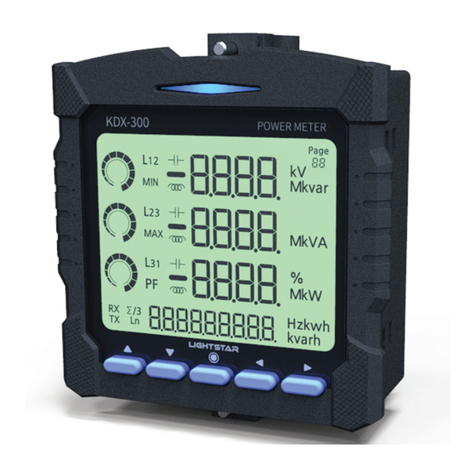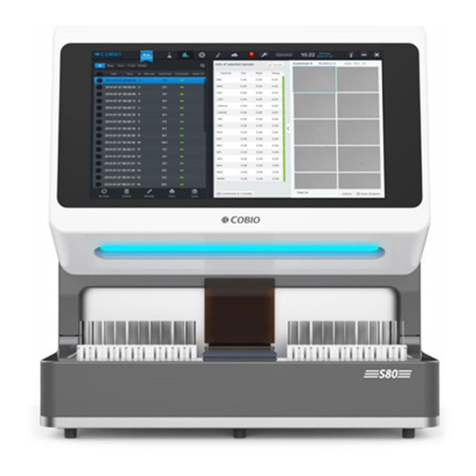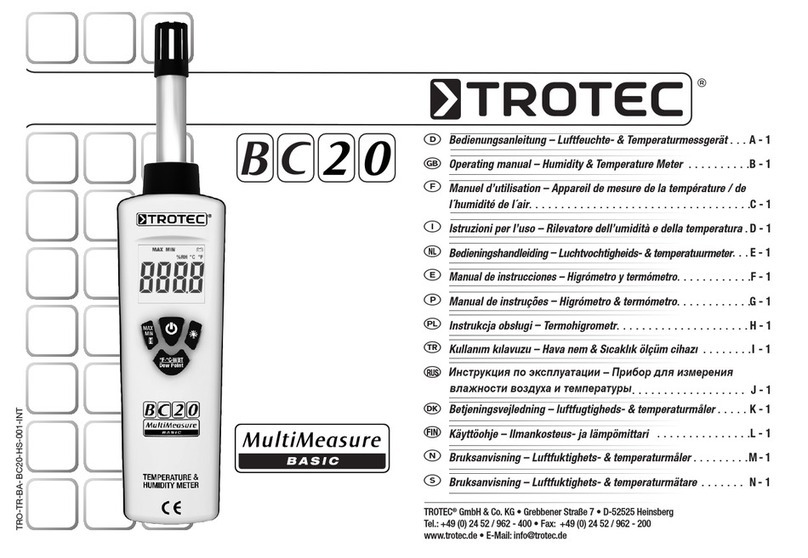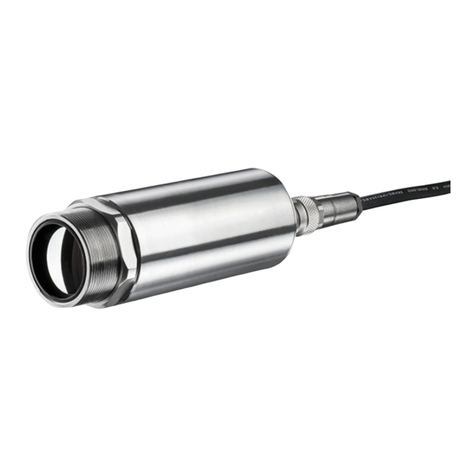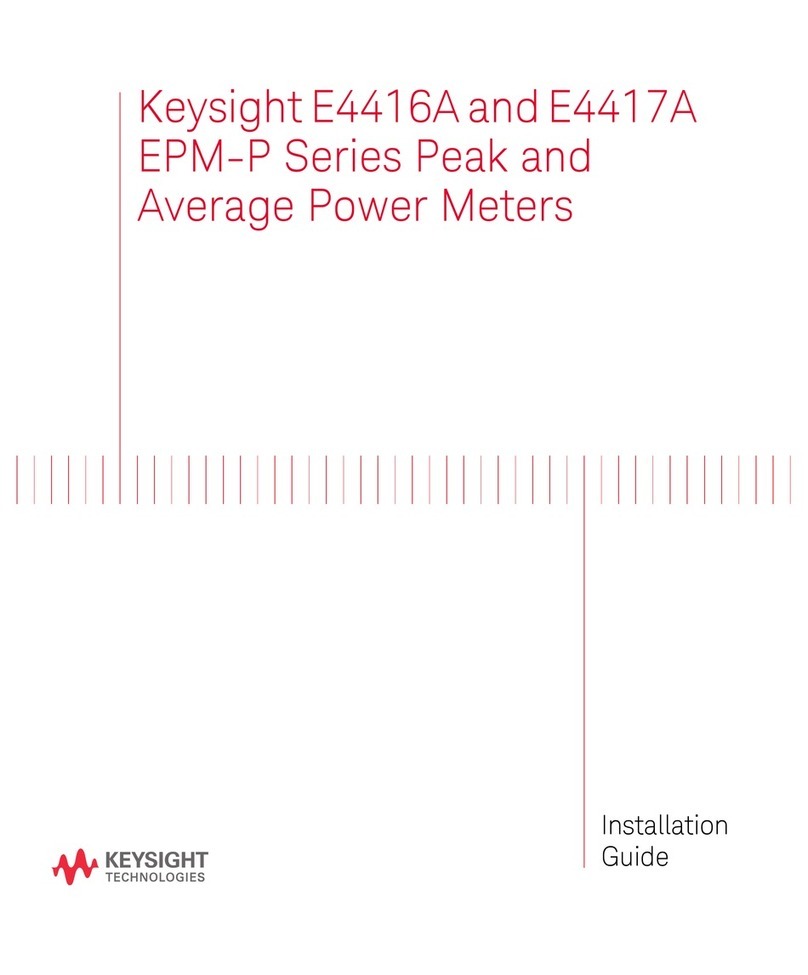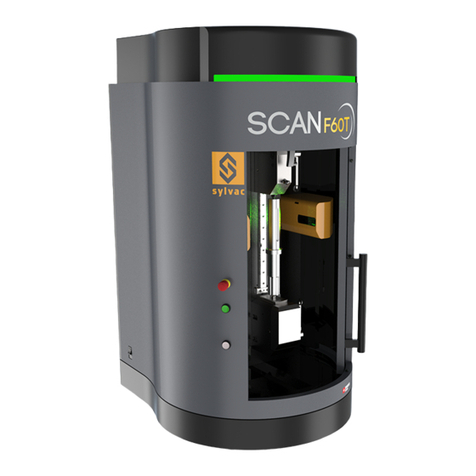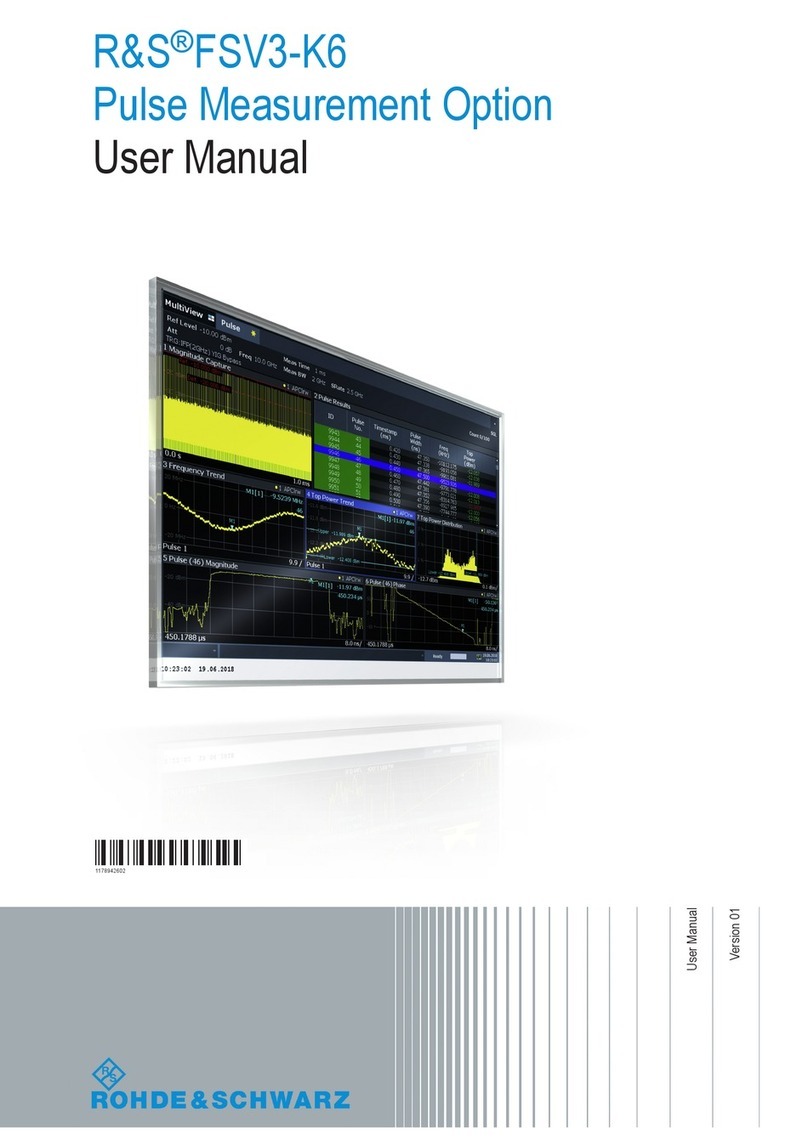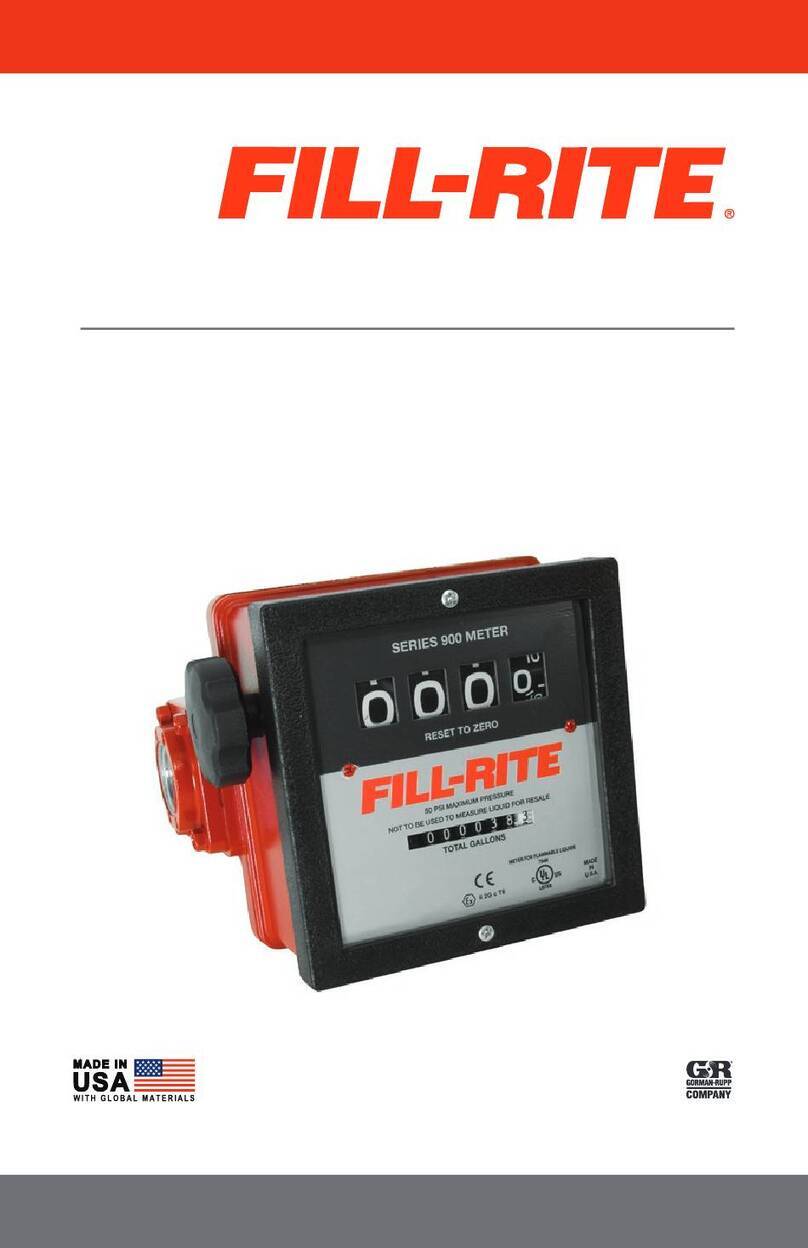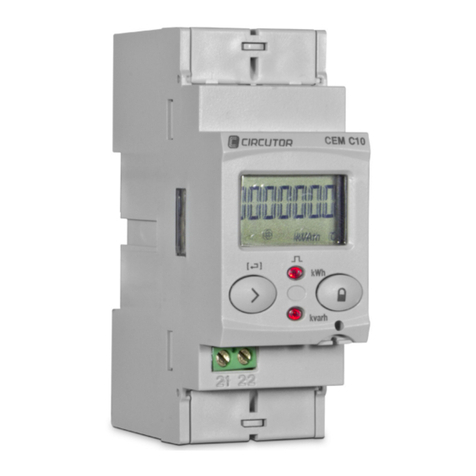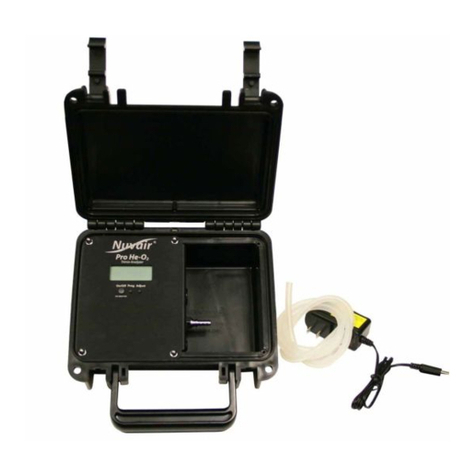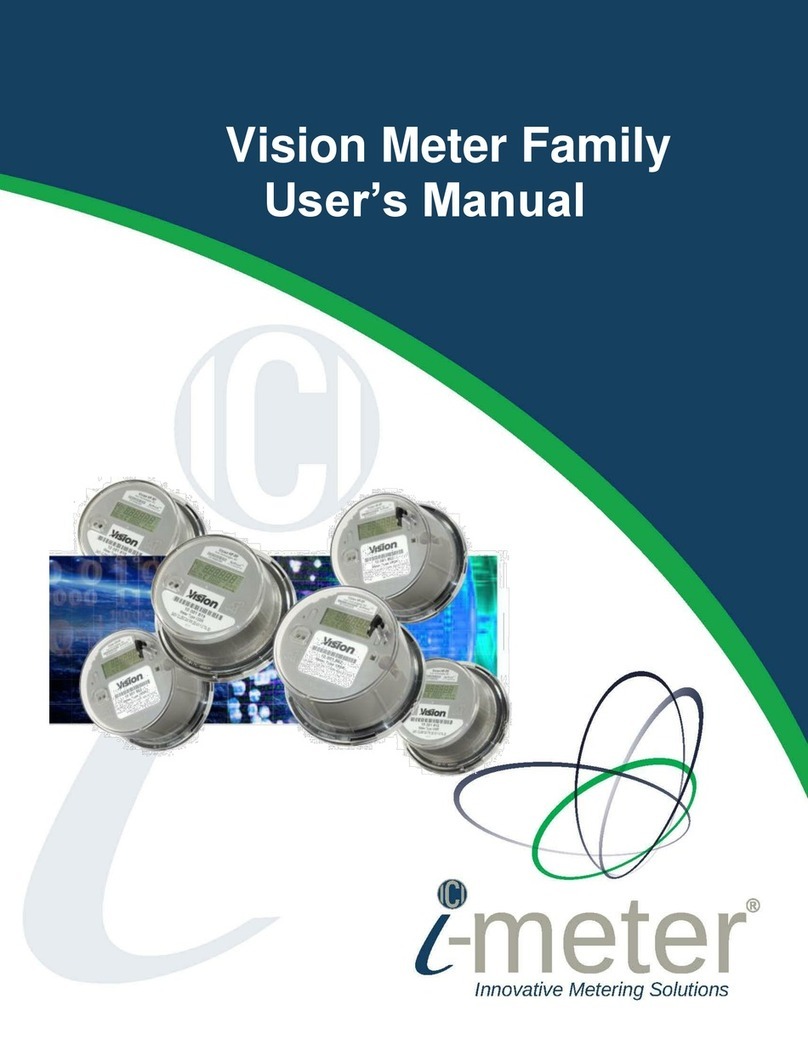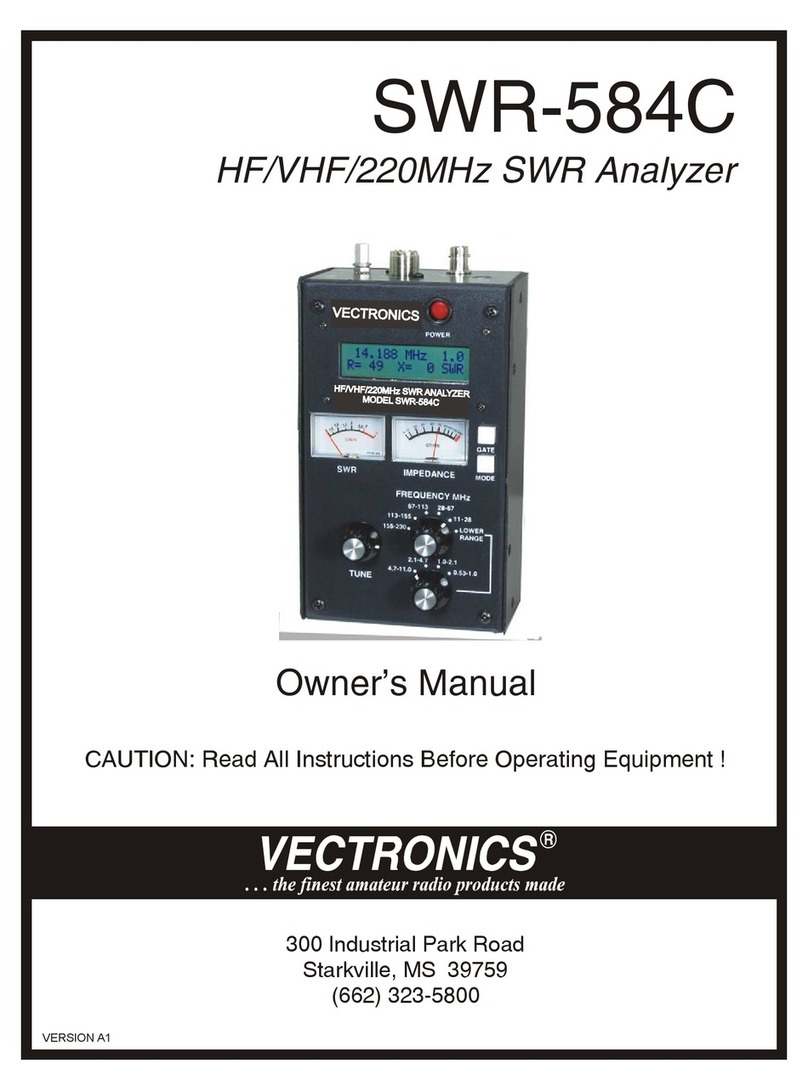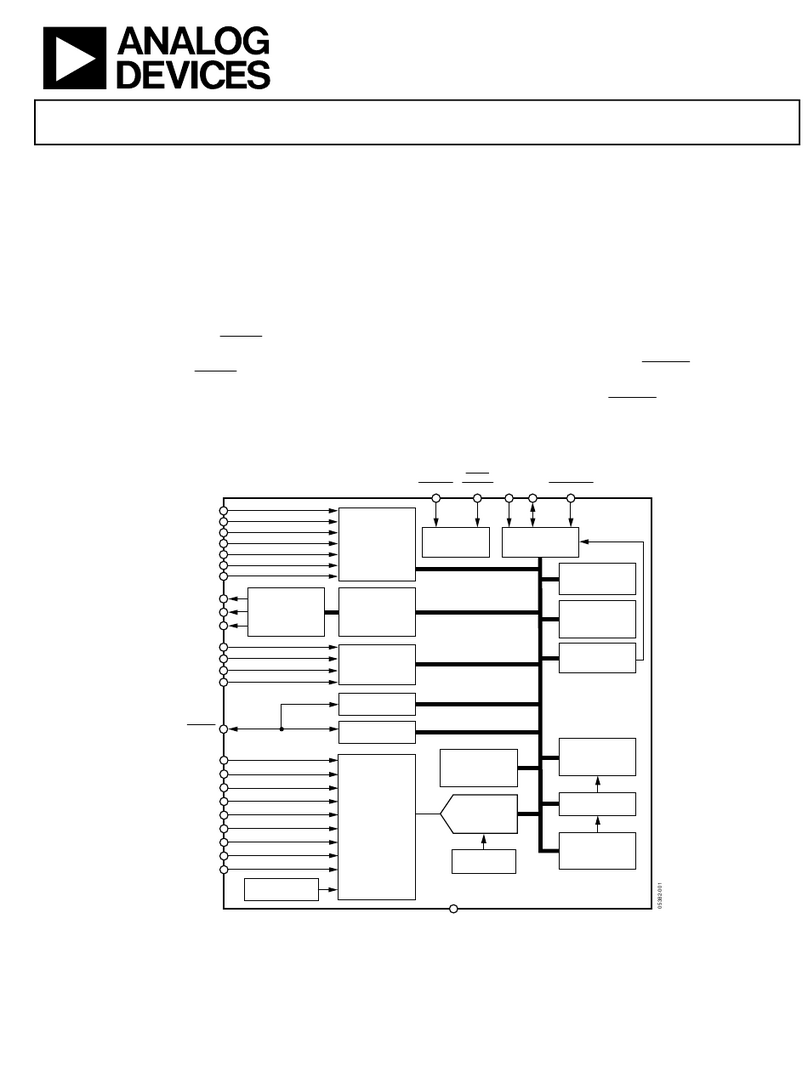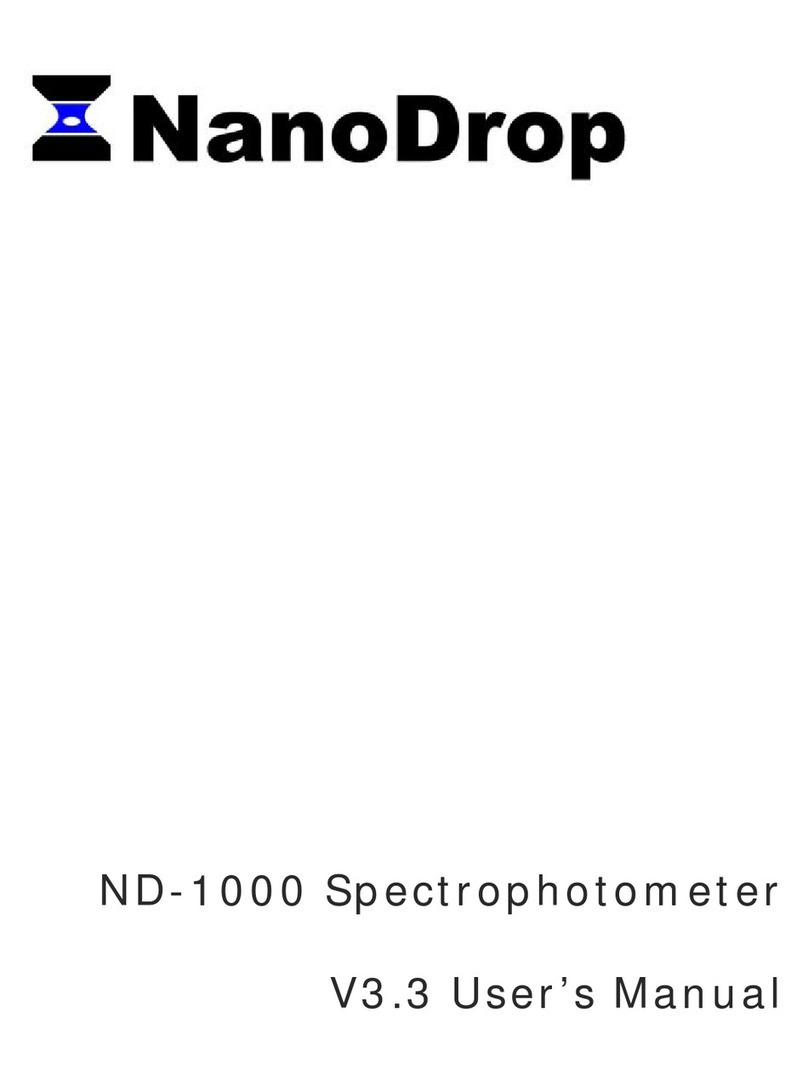Thermo Electron ELECTRA User manual

ELECTRA/SELECTRA
Ratemeter
Operators Manual
March 2004


© Thermo Electron Corporation 2005
ALL RIGHTS RESERVED.
REPRODUCTION IN WHOLE OR IN PART OF ALL MATERIAL IN
THIS PUBLICATION, INCLUDING DRAWINGS AND DIAGRAMS, IS
FORBIDDEN.
THIS INSTRUCTION MANUAL IS CONFIDENTIAL TO THERMO
ELECTRON CORPORATION AND IS SUPPLIED FOR USE ONLY IN
CONNECTION WITH THE OPERATION AND/OR MAINTENANCE OF
THE EQUIPMENT TO WHICH IT RELATES, AS SUPPLIED BY
THERMO ELECTRON CORPORATION. THE CONTENTS MUST
NOT BE USED FOR OTHER PURPOSES, NOR DISCLOSED TO ANY
THIRD PARTY, WITHOUT THE PRIOR WRITTEN CONSENT OF
THERMO ELECTRON CORPORATION.
Thermo Electron Corporation
Bath Road, Beenham, Reading, Berkshire. RG7 5PR. England.
Tel: 0118-9712121 Fax: 0118-9712835


WEEE Compliance:
This product is required to comply with the European Union’s Waste Electrical &
Electronic Equipment (WEEE) Directive 2002/96/EC. It is marked with the following
symbol:
Thermo Electron has contracted with one or more recycling/disposal companies in
each EU Member State, and this product should be disposed of or recycled through
them. Further information on Thermo Electron’s compliance with these Directives,
the recyclers in your country, and information on Thermo Electron products which
may assist the detection of substances subject to the RoHS Directive are available at
www.thermo.com/WEEERoHS


( i )
RATEMETER TYPE ELECTRA& SELECTRA
CONTENTS
01.03.04
1. INTRODUCTION..................................................................................................1
1.1 GETTING STARTED: QUICK OPERATION GUIDE .........................................................1
1.2 BASIC DESCRIPTION...........................................................................................................3
2. DETAILED DESCRIPTION................................................................................5
2.1 CASE .......................................................................................................................................5
2.2 ELECTRONICS ......................................................................................................................5
2.3 PROBE CALIBRATION ........................................................................................................6
2.4 PROBE INTERCHANGEABILITY (SELECTRA ONLY) ...................................................6
3. SPECIFICATION..................................................................................................7
3.1 PERFORMANCE....................................................................................................................7
3.2 DISPLAY ................................................................................................................................9
3.3 CONTROL ............................................................................................................................12
3.4 CONNECTORS.....................................................................................................................15
3.5 POWER SUPPLY .................................................................................................................15
3.6 ENVIRONMENTAL.............................................................................................................15
3.7 MECHANICAL (APPROXIMATE DIMENSIONS)...........................................................16
3.8 OPTIONAL EXTRAS...........................................................................................................16
4. OPERATING FUNCTIONS...............................................................................18
4.1 POWER SOURCES ..............................................................................................................18
4.2 FUNCTIONAL OPERATION ..............................................................................................19
4.3 INTERNAL SWITCHES S1 .................................................................................................28
4.4 POTENTIOMETERS ............................................................................................................28
5. TYPICAL PROBE SET UP PROCEDURE .....................................................29
5.1 DUAL SCINTILLATION PROBES.....................................................................................29
5.2 ALPHA & BETA SCINTILLATION PROBES ...................................................................34
5.3 GAMMA SCINTILLATION PROBES ................................................................................37
5.4 GEIGER COUNTRATE PROBE..........................................................................................40
5.5 DOSERATE PROBE.............................................................................................................43


( ii )
6. SELF TEST ROUTINES AND ERROR MESSAGES ....................................45
6.1 SELF TEST ROUTINES.......................................................................................................45
6.2 ERROR MESSAGES ............................................................................................................47
7. MAINTENANCE.................................................................................................49
7.1 CLEANING INSTRUCTIONS .............................................................................................49
8. UPGRADES..........................................................................................................50
DRAWINGS
GENERAL ASSEMBLY E38718/A, B & C
OUTLINE DRAWING C38719


( iii )
SAFETY INFORMATION
WARNING SYMBOLS
The following is an explanation of the warning symbols seen on the instrument. Please read
this information before using and/or maintaining this equipment.
As seen on End Plate 1 near the battery compartment lid.
CAUTION:
Only use battery types defined in this manual
complying with IEC 86-1&2. Insert batteries
with correct polarity (see the drawing on the back
label).
As seen on End Moulding 2 near the DC input label.
CAUTION:
CAUTION:
Only use approved power supply adaptors from
the list in section 3.8. The power supply should
not be capable of delivering more than 250 mA
DC current.
Do not recharge non-rechargeable, primary,
alkaline manganese cells. When using these cells,
ensure the end cap covers the DC INPUT jack
under the end moulding (as set in the factory).
As seen on End Moulding 2 near the Probe label.
CAUTION:
Risk of non hazardous electric shock.
Turn the instrument off before connecting and
disconnecting probe. High voltage up to 1400 V
(maximum power 45 mW) at the probe connector.


( iv )
As seen on the component side of the HV/Amplifier Board Type
5460A/B/C.
CAUTION: Risk of hazardous electric shock. The
circuit board poses no danger when inside the
instrument however only qualified, approved
Service personnel should attempt to service the
instrument. Details are contained in the Service
Manual.
WARNING AGAINST IMPROPER USE
The protection provided by this equipment may be impaired if used in a manner not specified
by the manufacture. The user must adhere to all the safety precautions noted above and to
individual warnings contained within this manual.
POWER SUPPLY
This instrument should be powered by the following methods:-
Power Supply Adaptor: Output 5 V ±0.25 V DC , maximum current 250 mA (for
battery charging).
Batteries (Quantity 3): Re-chargeable cells type IEC KRH 27/50 (C size).
Primary cells (alkaline manganese) Type IEC LR14 (C size)
For further details see section 3.5.


( v )
IMPORTANT INFORMATION
EC LIMITATIONS OF USE
For EC users only:
Instruments manufactured after 1.1.96 are compliant with the EC EMC Directive
89/336/EEC (amended by 92/31/EEC & 93/68/EEC) and bear the CE mark. To
maintain compliance with this directive, the following should be observed:
•Headphones should not be used with the instrument in the EC.
•Only adequately screened cables should be used with the instrument: Thermo ‘curly’
cables 3190A - 3192A, 3201A & 3203A may not offer adequate screening.
•The instrument should be operated with batteries only in a harsh r.f. environment. In
other environments, only Thermo Electron approved DC Adaptors should be used in
place of batteries. These Adaptors include a ferrite tube close to the +5 V connector.
•CE marked Selectra instruments should only be used when connected to Intelligent
Probes having adequately screened cables, Thermo Type 3212, less than 3 metres in
length. Connecting probes which have integral cable may render the Selectra non
EMC compliant.
•The AP6A, BP17A and DP8A probes should be of modified design before they are
used with CE marked Delta5 instruments. The modification is identifiable on the
serial number label as MOD. record 1.
•Maintenance: details of necessary actions are given in the maintenance section of this
manual.
For other users:
Where headphones may be used, the headphone socket on CE marked units is of
professional grade; it may not be compatible with plugs found on low-cost personal
stereo headphones. Contact the Service Department if difficulties arise.


- 1 -
1. INTRODUCTION
The ELECTRA is a portable ratemeter for use with a variety of GM and Scintillation probes for
the measurement of Radioactive Contamination and Radiation.
The SELECTRA is a portable ratemeter derived from the ELECTRA, dedicated for use with
the Thermo Electron range of ‘intelligent’ GM and Scintillation ‘I’ series probes for the
measurement of Radioactive Contamination and Radiation.
Upon connection of a suitable ‘I’ series probe, the SELECTRA will interrogate the probe’s on-
board memory store containing the probe’s operating parameters and overwrite the
SELECTRA SET UP parameters with these values/options. This enables the SELECTRA-
probe combination to commence monitoring immediately without the need to reset the SET UP
parameters for the probe required.
The SELECTRA has been designed to provide accuracy in the lower level discriminator and
high voltage settings. This accuracy enhances consistency between the performance of
SELECTRA (and ELECTRA) units. This consistency implies that ‘I’ series probes can be
interchanged between any number of SELECTRA units without variation in probe
performance.
1.1 GETTING STARTED: QUICK OPERATION GUIDE
The following is a brief guide only; full details of operational modes can be found in section 4.
1.1.1 Switch - on
press
⇒RatemeterMode
1.1.2 Rate →Integrate
press
⇒Integrate Mode
To see elapsed time:
press
⇒10 s
(This feature toggles with the integrate count).
To stop integration:
press
⇒Final Result

- 2 -
1.1.3 Integrate →Rate
press
⇒Ratemeter Mode
1.1.4 Modify Parameters
First press
⇒Parameter List
then use
/
to find the
parameter
⇒
3
then press
Parameter flashes to
show edit mode 3
then use
/
to select the
required
value
⇒19.50
then press
new value registered
3
finally press
for change to take
effect Ratemeter Mode
1.1.5 Other Functions
stores background at any time during
ratemeter mode
or at the end of
integration
toggles to enable / disable
sound
and mutes alarm sound
temporarily
changes display and sound
of incoming particles
from αto βto α+ βor Displays integrated
dose for Geiger
probes
provides backlight one press gives 30 seconds or three quick presses
for continuous
operation
inhibits changes to
parameters
use within parameter list
view
1.1.6 Switch - off
press
⇒unit off

- 3 -
1.2 BASIC DESCRIPTION
The unit consists of two circuit boards, an HV/Amplifier board and a Processor and Interface
board, housed in a painted rectangular section aluminium extrusion. Two end plates hold the
boards in place and locate the battery holder. A further two plastic end caps prevent
unauthorised adjustment of the internal switches, adjustment of the sounder audible level and
interference with the power sources available. The LCD display is positioned upon the
processor board and is visible through a screen on the top panel of the extrusion. The handle,
also positioned on the top panel of the extrusion, provides ease of use even with protective
gloves.
Probes can be connected to the unit via a connector attached to the HV/Amplifier board and
protruding at the far end of the unit from the handle.
Operation of the unit and entry of setup parameters can be performed via a membrane keypad
on the top panel; audible feedback is provided to ensure correct keying even with heavy
protective clothing; the membrane keys are also embossed, having a tactile feel.
Display of measured rate is in both analogue and digital formats on a high contrast LCD. The
display is auto ranging and capable of displaying Counts per second or Counts per minute for
countrate measurements, Bq, disintegrations per minute (dpm) and Bq/cm2 for contamination
measurements or sieverts per hour or roentgens per hour or grays per hour, with the appropriate
probes, for doserate measurement. The analogue display is in the form of a bargraph which has
a logarithmic scale covering three decades with autoranging to accommodate two further
decades. The display has a backlight for use in low light conditions, which is operated by a key
on the front panel.
Audible indication of measured rate is given by an internal sounder and an external socket is
provided at the handle end to enable the audible output to be transferred to headphones. A pot
situated under the outer end cap is available for volume control of the audible output.
Alarms can be given, as a continuous tone on the sounder, and an indication on the display, if
the measured rate exceeds a presettable level. The alarm level can be set over a wide range, or
disabled, by digital control.
With Thermo Dual Scintillation probes, alpha and beta contamination can be monitored
simultaneously, with separate tones on the sounder, and independent alarm levels for each
particle type. The display of rate can be selected to be for either type of particle or for the sum
of both.
For use with gamma scintillation probes an energy selection facility is available, with an upper
threshold which can be adjusted by the user from the keypad.
In GM setting, an integrated dose is performed. This can be viewed during most operations by
selecting the channel view button (α/β).
The required operating modes for use with scintillation or GM based instruments can be set up
by the SET UP key on the keypad. Unauthorised adjustment of these parameters can be
prevented by selection of an internal switch situated underneath the end cap of the unit.
The instrument normally measures rate, but for more accurate measurement an integrate mode
is provided, with presettable integrate times. A background subtraction facility is provided
which can be activated or deactivated from the keypad.

- 4 -
Battery backup of all entered parameters and alarm levels is maintained when the batteries are
removed. The instrument is prevented from rate measurement should the parameters become
corrupted due to failure of the backup battery.
The unit is powered by three standard ‘C’ size cells of either Primary or rechargeable type.
Rechargeable cells may be recharged in the unit by means of an optional mains operated
charger which can be connected via a socket in the end of the unit. The charger unit also
doubles as a DC supply, which can be used without batteries fitted, if the unit is installed in a
fixed position.
A test mode is provided to aid customer testing and error messages are provided in normal use
to assist fault finding and diagnosis.
There are two versions of the ELECTRA:
ELECTRA1A is to be fitted with a PET probe connector.
ELECTRA1B is fitted with an MHV connector.
This manual suits for next models
1
Table of contents
Other Thermo Electron Measuring Instrument manuals
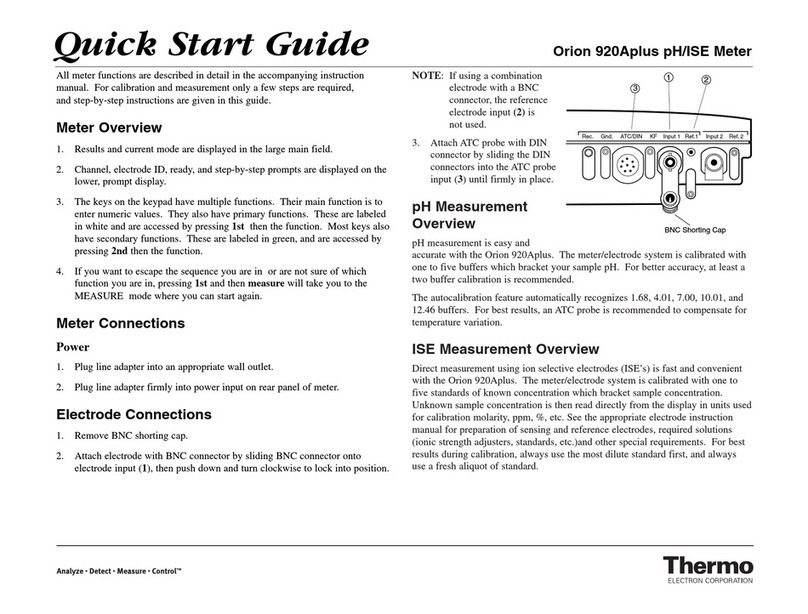
Thermo Electron
Thermo Electron Orion 920Aplus User manual
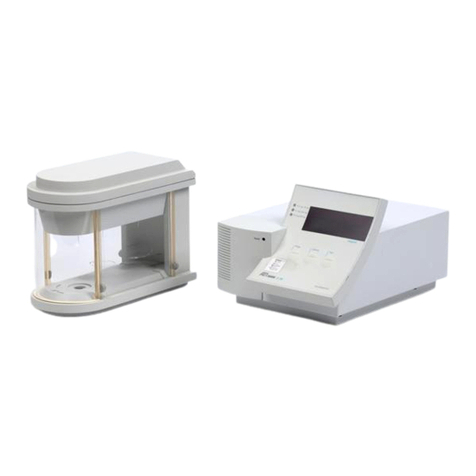
Thermo Electron
Thermo Electron Cahn C-34 User manual
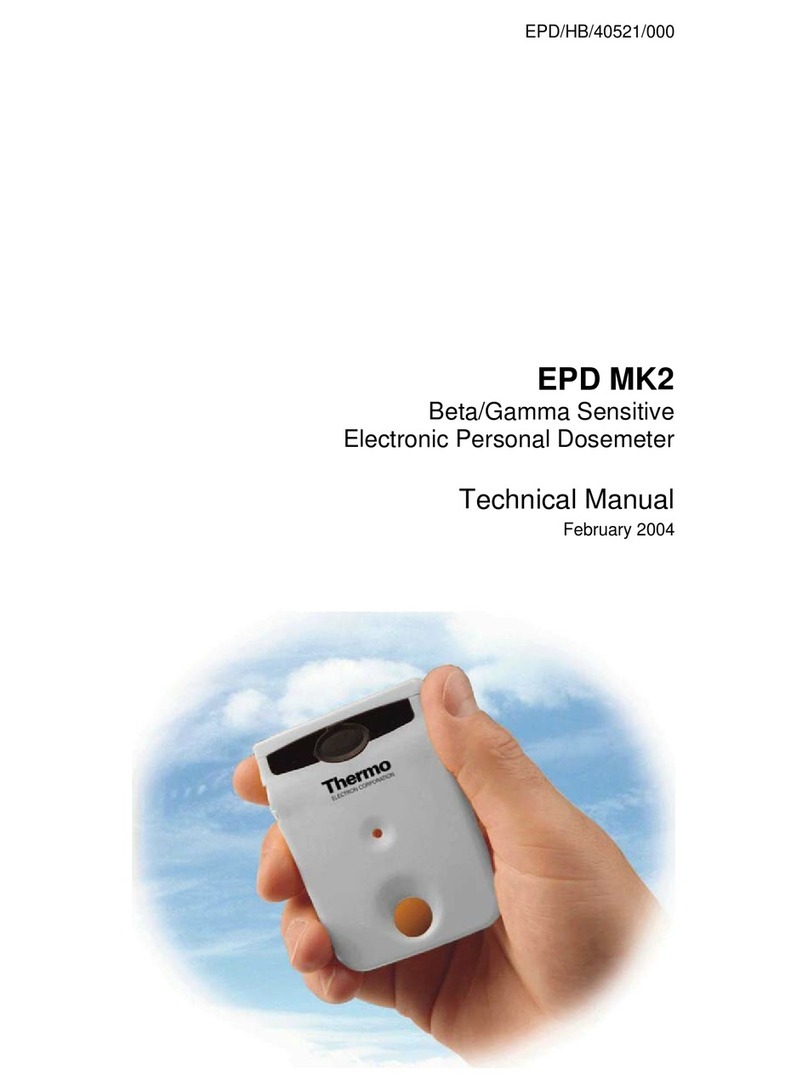
Thermo Electron
Thermo Electron EPD MK2 User manual

Thermo Electron
Thermo Electron PURE WATER Orion 1817LL User manual
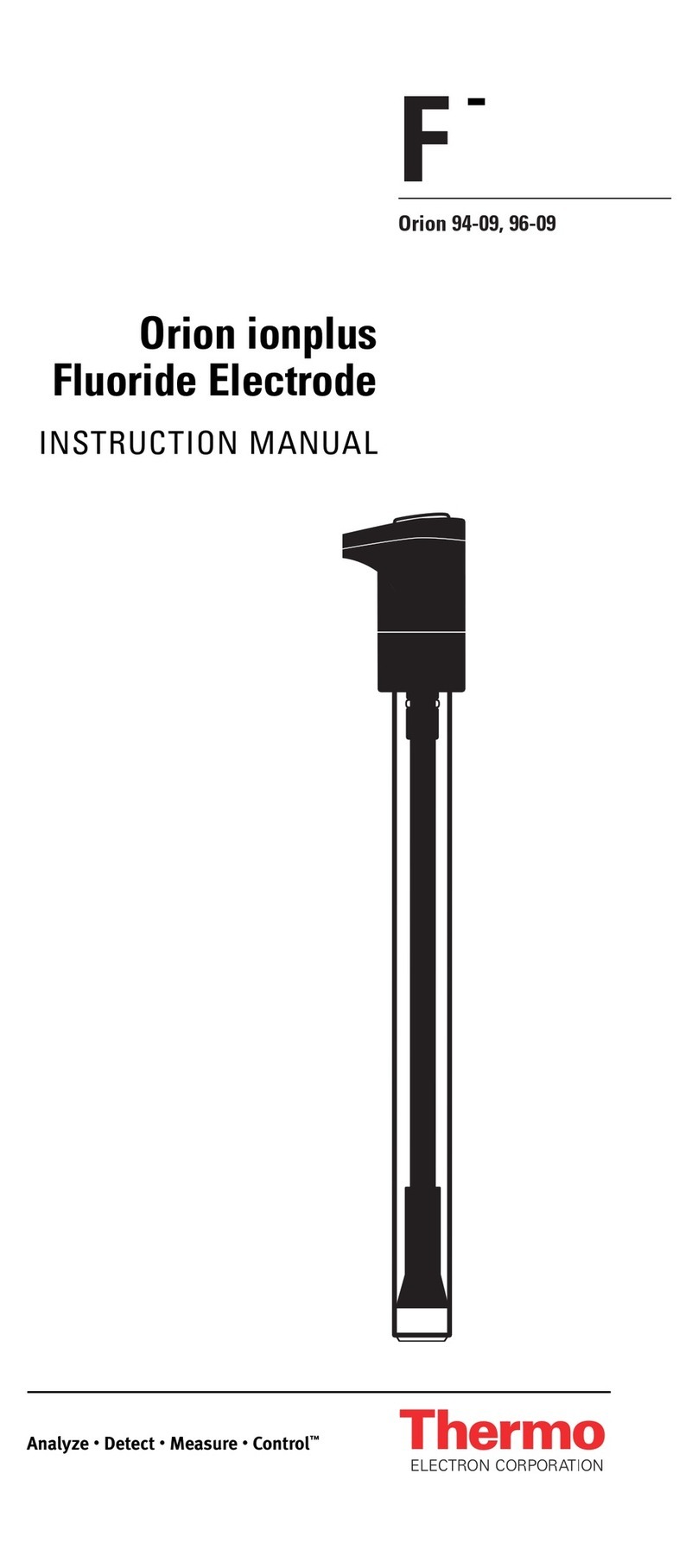
Thermo Electron
Thermo Electron 96-09 User manual
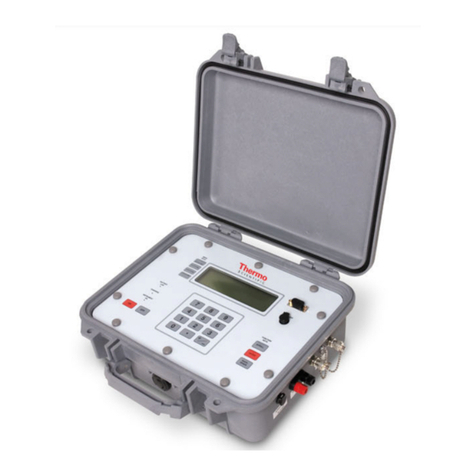
Thermo Electron
Thermo Electron Polysonics SX30 User manual
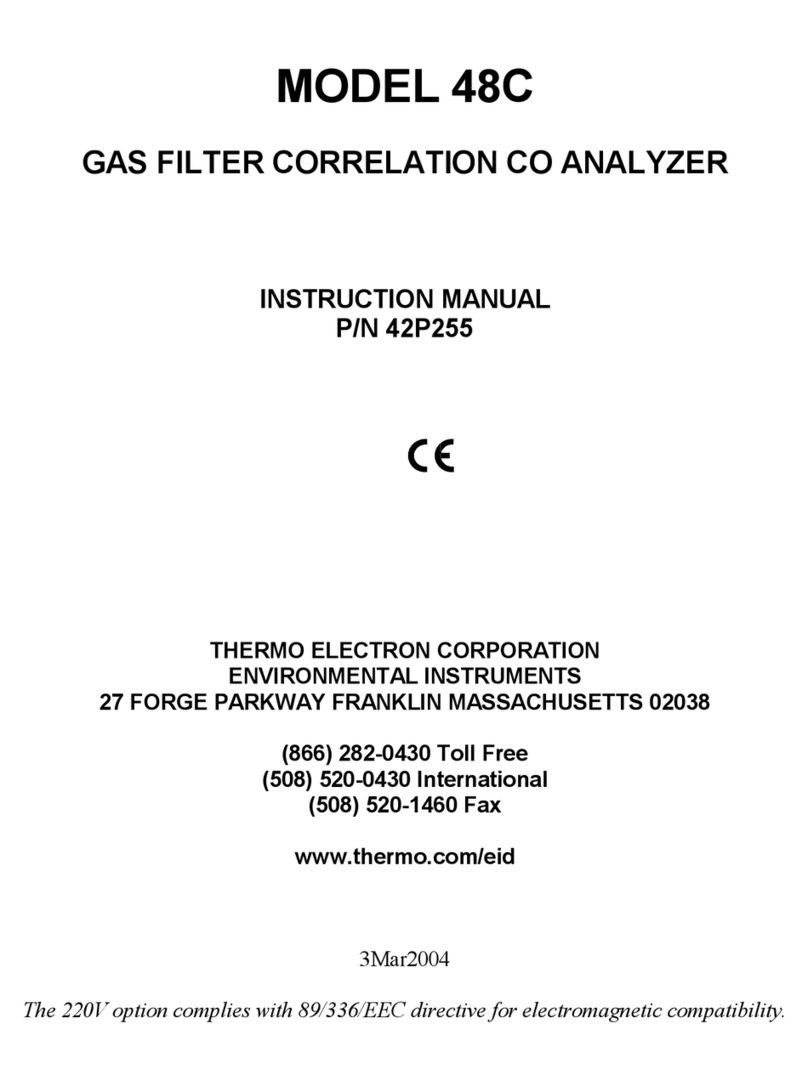
Thermo Electron
Thermo Electron 48C User manual
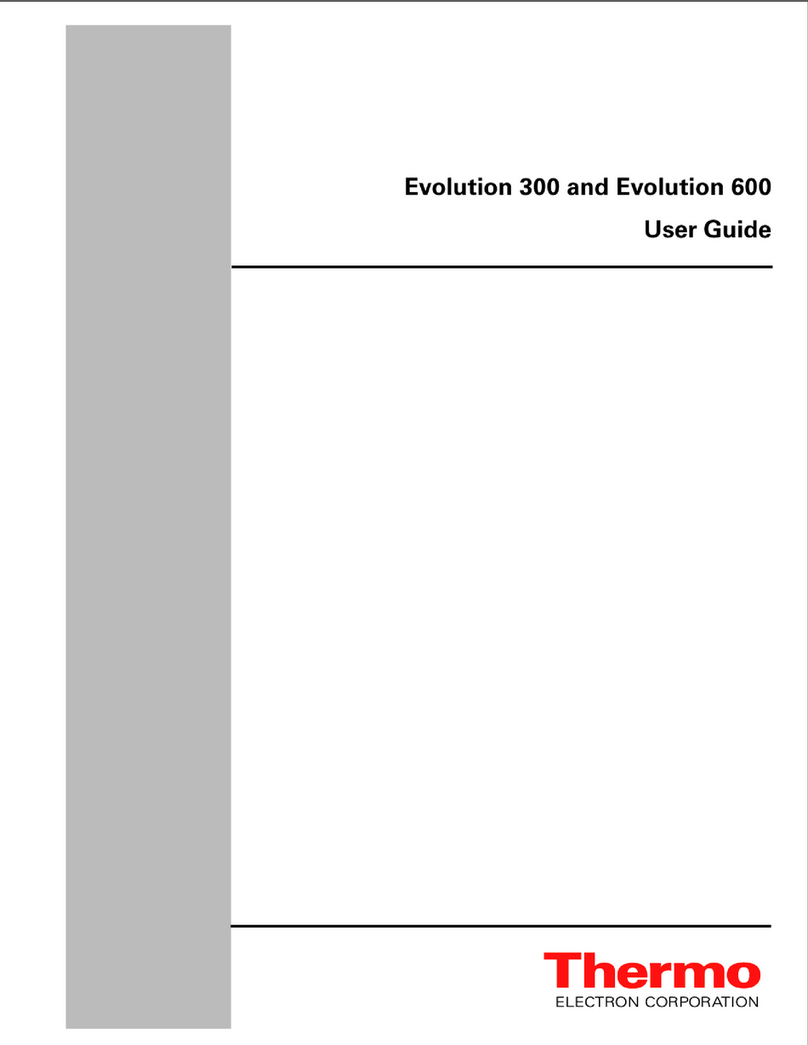
Thermo Electron
Thermo Electron Evolution 300 User manual

Thermo Electron
Thermo Electron Nicolet 380 User manual
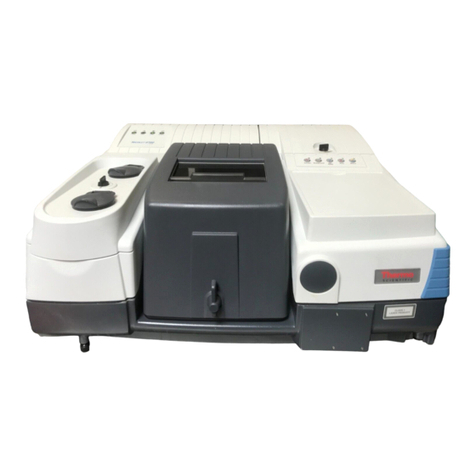
Thermo Electron
Thermo Electron Nicolet 4700 User manual


